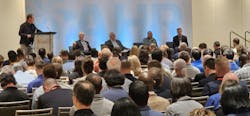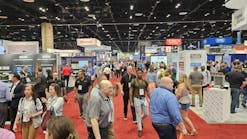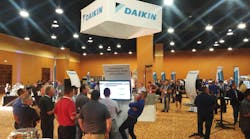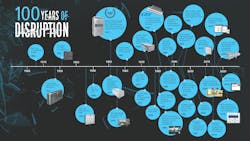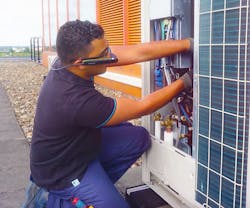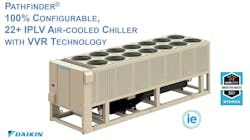Arguably the most overused buzzword in modern business-speak is the term “disruption.” A simple Google search of the term “HPAC engineering disruption” yields over 17 million results.
So, business reporters like me can be forgiven if we roll our eyes, at least initially, when we see yet another industry event breathlessly billing itself as “disruptive” to life as we know it. To borrow from the ongoing MLB.com TV ads, “Oh yeah? Prove it.”
Healthy skepticism aside, of course, there is still an undeniable and fundamental shift ongoing today across most industries and ours is no exception. The swirling combination of new technology, evolving workforce demographics and even climate change are driving enormous creativity and innovation to meet marketplace demands. And they are forcing more parties to work more closely together to solve problems more quickly and more efficiently.
In fact, “partnership is the new leadership,” said Elizabeth Heider, FAIA, chief sustainability officer at contracting giant Skanska USA, speaking last month in San Antonio, Tex., at manufacturer Daikin Applied’s 2017 Disruption Tour, a bi-annual showcase for customers, dealers and the trade press. Based in Alexandria, Va., Heider was one of several provocative speakers who reminded attendees that these are no ordinary times. In particular, she stressed that those in our market had best become familiar with the new WELL Building Standard, which is seen as an holistic evolution of LEED certification for “next generation buildings and the people who will occupy them.”
Unstoppable forces
Her words fit well with the event’s parallel emphasis on new products and services that aim to increase efficiency, boost performance, and cut operation and maintenance costs, all while leaving a smaller carbon footprint. “The move to ‘net zero’ is real,” said Daikin Applied CEO Mike Schwartz, and the Minneapolis-based subsidiary is acting accordingly.
Doubling down on its commitment to disruptive technology, Schwartz announced that his firm has opened a new office in San Jose, in the heart of Silicon Valley, which it is staffing with more than 200 engineers focused on the Internet of Things (IoT) and artificial intelligence (A.I.) applications to the core business. Daikin also noted that it is testing smart glasses for field technicians in the Netherlands, which it expects to roll out globally in 2018. At the same time, the HVAC manufacturer is still bringing its new $417-million Daikin Texas Technology Park outside of Houston into full operation. Unharmed by the recent hurricanes, the massive, 4.1-million-sq-ft facility is the largest new structure under one roof to be built in the U.S. this century. (Only Boeing Corp.’s airplane assembly plant in Everett, Wash., is larger.)
- Texas Technology Park opened in 2016 as the second-largest U.S. factory under one roof.
The aggressive capital investment is driven both by strong market demand in North America, as well as by supportive pressure from Daikin’s corporate parent in Osaka, Japan. “We’re changing the way we think about HVAC,” added CEO Schwartz. The goal now is “to create smarter, more configurable solutions that empower owners and managers to optimize building environments for their people.”
Emphasizing the interconnectedness of its new products and the enhanced ability to monitor, adjust and analyze the billowing clouds of data, both big and small, now being generated, the product specialists said they were equally determined to focus on customer feedback, as well. Striking that balance in a hyper-competitive market can be delicate, at best.
“If you don’t like change, you’re going to like irrelevance even less,” said tech innovator and conference keynote Terry Jones, founder of both Travelocity and Kayak.com. Today, he is chairman of Austin, Tex.-based Wayblazer, a “travel recommendation engine.” Jones reminded the audience of companies that were once household names, but who failed to adjust to their marketplace. “Look at Kodak,” he said. “Photography didn’t go away. Kodak did.”
Stressing that we now clearly live in the "Information Age", Jones added that how industry uses ‘big data’ will be the difference-maker, especially as it develops smarter machines and even autonomous vehicles. “If data is the oil of the 21st century, then A.I. will be the refinery,” he said.
To stay afloat and avoid Kodak's instructive fate, firms will have to be proactive in researching the investments they will need to make to stay competitive. But at the end of the day, they will have to spend.
“Nothing is more expensive than cheap,” cautioned Mark Sauer, an Atlanta-based facilities manager for a joint venture of Anheuser Busch and Keurig. (Yes, believe it or not, top minds are working on a beer that can be home-brewed in a cup, aiming for a pilot test next spring.) Sauer is also co-founder of the American Chief Engineers Society (ACES), a 1,500-person, national nonprofit dedicated to disseminating best practices and trouble-shooting answers for members across the U.S. He urges his fellow chief engineers to stay on top of the latest technology that can help them to do their jobs better.
- How-to Headset: Daikin is piloting smart field glasses in Europe.
Toward that end, at the conference, Daikin Applied presented new products, services and operational best practices that emphasized smart, data-driven solutions. They included:
· Data acquisition and analytics: Intelligent Equipment® (IE) connects directly to 150 data points on rooftop units and 350 data points on air-cooled chillers to monitor energy consumption at the equipment level for deeper, more accurate performance measurement;
· Remotely connected rooftop units: Daikin’s rooftop product line is now IE-enabled and provides temperature and humidity control, enhancing the quality of the occupied space. In San Antonio, Daikin previewed its latest enhancement of Rebel: The Commercial Packaged 20-ton Heat Pump Rooftop with inverter scroll compression. The modulation of the variable speed compressor equates to 30 percent energy savings relative to ASHRAE 90.1-2016 part-load minimums;
· Next-generation magnetic bearing chillers: The Magnitude® centrifugal chillers feature magnetic bearing technology that eliminates the need for oil, mechanical seals and gears, enabling longer machine life, as well as better efficiency and reliability that can save end users up to $4 million in energy costs over the lifetime of the chiller. Daikin’s RideThrough® and RapidRestore® technologies allow chillers to maintain stable operation during short power outages and improve restart times, if needed;
· Smart, compact water source heat pumps: Daikin’s SmartSource® compact vertical water source heat pumps pack high-performance features into a 48 percent smaller footprint, providing engineers, contractors and facility managers with a solution that frees up space, as well as lowers energy usage and installation costs;
· PreciseLine™ Large Capacity Blower Coil: Daikin’s large capacity horizontal blower coil conditions air to precise levels up to 5000 cfm, designed to match a building’s air handling demand at a blower coil price point. The offering is a more compact unit that meets building demands while maximizing space – helping facility managers’ condition air for a larger space in a smaller package at an affordable price. And, its double-wall construction minimizes airborne pathogens and contaminants to provide better re-circulation of room air and improved indoor air quality;
· Flexible fan arrays: Award-winning ECM fan arrays for Daikin’s Vision® and Skyline® semi-custom air handlers use 46 percent less cabinet space while delivering higher efficiencies and less noise. With the ability to accommodate up to 20 fans in 40 different arrangements to meet application requirements, along with fan and motor redundancy to ensure reliability, ECM fan arrays for indoor and outdoor air handlers are suited for mission-critical facilities where extra space is limited;
· Air-cooled chillers: Daikin’s Pathfinder® (screw) and Trailblazer® (scroll) chillers are available with IE to help building owners and facility managers transform how they manage their HVAC equipment. Trailblazer chillers are designed for low-install costs and high performance with up to 10 percent better efficiency than competing offerings. Pathfinder AWV features the industry-first Variable Volume Ratio (VVR) technology, which allows the chiller’s compressor to optimize performance for every condition and at every hour of the day, significantly improving efficiency levels. Pathfinder was recognized as a 2017 AHR Expo Innovation Award Winner for the cooling category.
For more information on these products and other company news, visit www.daikin.com.
